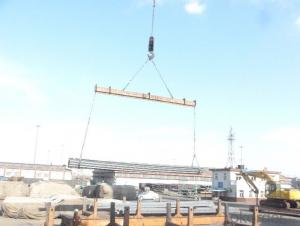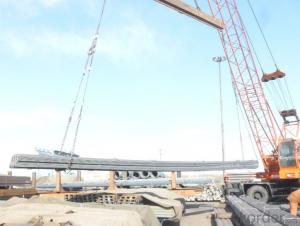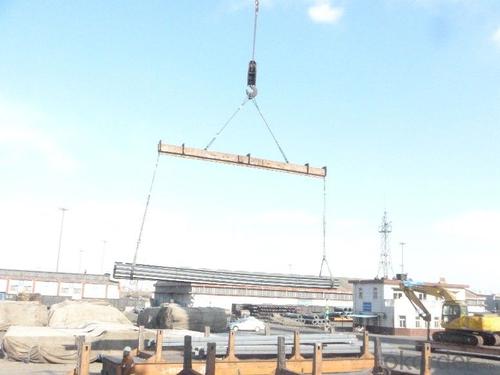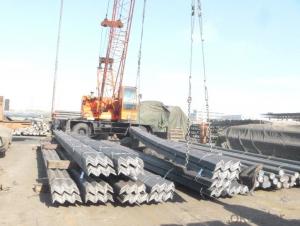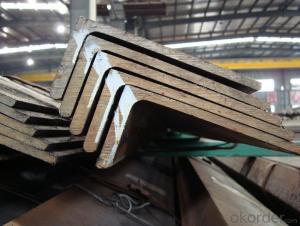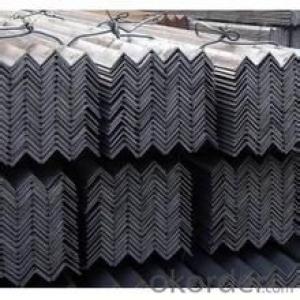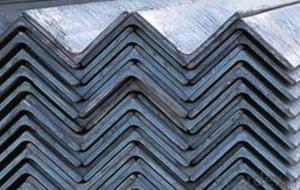hot rolled alloy angle steel
- Loading Port:
- China Main Port
- Payment Terms:
- TT OR LC
- Min Order Qty:
- -
- Supply Capability:
- -
OKorder Service Pledge
OKorder Financial Service
You Might Also Like
Product Description:
Product Description:
Specifications of Angle Steel
1. Invoicing on theoretical weight or actual weight as customer request
2. Length: 6m, 9m, 12m as following table
3. Sizes
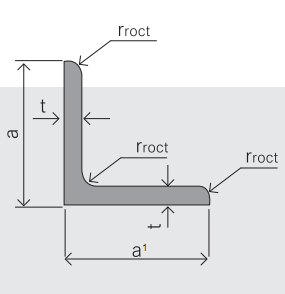
Sizes: 25mm-250mm | ||
a*t | ||
25*2.5-4.0 | 70*6.0-9.0 | 130*9.0-15 |
30*2.5-6.6 | 75*6.0-9.0 | 140*10-14 |
36*3.0-5.0 | 80*5.0-10 | 150*10-20 |
38*2.3-6.0 | 90*7.0-10 | 160*10-16 |
40*3.0-5.0 | 100*6.0-12 | 175*12-15 |
45*4.0-6.0 | 110*8.0-10 | 180*12-18 |
50*4.0-6.0 | 120*6.0-15 | 200*14-25 |
60*4.0-8.0 | 125*8.0-14 | 250*25 |
5. Payment terms:
1).100% irrevocable L/C at sight.
2).30% T/T prepaid and the balance against the copy of B/L.
3).30% T/T prepaid and the balance against L/C
6.Material details:
Alloy No | Grade | Element (%) | | ||||
C | Mn | S | P | Si | | ||
| | |||||||
|
|
|
|
|
|
| |
Q235 | B | 0.12—0.20 | 0.3—0.7 | ≤0.045 | ≤0.045 | ≤0.3 | |
|
|
|
|
|
|
| |
Alloy No | Grade | Yielding strength point( Mpa) | | ||||
Thickness (mm) | | ||||||
≤16 | >16--40 | >40--60 | >60--100 | | |||
≥ | | ||||||
|
|
|
|
|
| | |
Q235 | B | 235 | 225 | 215 | 205 | | |
Alloy No | Grade | Tensile strength (Mpa) | Elongation after fracture (%) | | |||
Thickness (mm) | | ||||||
| ≤16 | >16--40 | >40--60 | >60--100 | | ||
≥ | | ||||||
|
|
|
|
|
|
| |
Q235 | B | 375--500 | 26 | 25 | 24 | 23 | |
Usage & Applications of Angle Steel
According to the needs of different structures, Angle can compose to different force support component, and also can be the connections between components. It is widely used in various building structures and engineering structures such as roof beams, bridges, transmission towers, hoisting machinery and transport machinery, ships, industrial furnaces, reaction tower, container frame and warehouse etc.
Packaging & Delivery of Angle Steel
1. Packing: it is nude packed in bundles by steel wire rod
2. Bundle weight: not more than 3.5MT for bulk vessel; less than 3 MT for container load
3. Marks:
Color marking: There will be color marking on both end of the bundle for the cargo delivered by bulk vessel. That makes it easily to distinguish at the destination port.
Tag mark: there will be tag mark tied up on the bundles. The information usually including supplier logo and name, product name, made in China, shipping marks and other information request by the customer.
If loading by container the marking is not needed, but we will prepare it as customer request.
Production flow of Angle Steel
Material prepare (billet) —heat up—rough rolling—precision rolling—cooling—packing—storage and transportation
- Q: Can steel angles be used in marine or coastal environments?
- Yes, steel angles can be used in marine or coastal environments. Steel angles, also known as angle irons, are commonly used in various construction projects, including those in marine or coastal environments. However, it is essential to choose the right type of steel angle with appropriate corrosion resistance properties to withstand the harsh conditions of saltwater, moisture, and constant exposure to sea spray. Stainless steel angles are an excellent choice for marine or coastal applications due to their superior corrosion resistance. Stainless steel contains chromium, which forms a protective oxide layer on its surface, preventing rust and corrosion. This makes stainless steel angles highly resistant to the corrosive effects of saltwater and moisture. Galvanized steel angles are another viable option for marine or coastal environments. Galvanization involves coating steel with a layer of zinc, which acts as a sacrificial barrier against corrosion. This protective zinc coating helps prevent the underlying steel from rusting and deteriorating in saltwater or high humidity conditions. It is crucial to ensure proper maintenance and care of steel angles in marine or coastal environments. Regular inspection, cleaning, and applying appropriate protective coatings can help extend the lifespan of steel angles and maintain their integrity against the corrosive elements. In summary, steel angles can indeed be used in marine or coastal environments. However, it is necessary to select the right type of steel angle with suitable corrosion resistance properties, such as stainless steel or galvanized steel, and maintain them properly to ensure their longevity and structural integrity.
- Q: How do steel angles perform in high-humidity environments?
- Due to their corrosion-resistant properties, steel angles exhibit excellent performance in high-humidity environments. While the air's moisture content often causes metals to rust and corrode, steel angles are specifically engineered to withstand these conditions. Typically manufactured using stainless steel or galvanized steel, both materials possess a protective layer that effectively hinders rust formation. Consequently, steel angles are exceptionally well-suited for utilization in regions with high humidity, such as coastal areas or industrial settings where moisture is abundant. Moreover, their durability and extended lifespan further contribute to their exceptional performance in high-humidity environments.
- Q: What is the maximum length of a steel angle that can be transported?
- The maximum length of a steel angle that can be transported depends on various factors such as the transportation method, the size and weight restrictions of the vehicle used, and any legal limitations imposed by local regulations. However, in general, steel angles are commonly transported in lengths ranging from 20 to 40 feet, which are standard sizes for shipping containers and flatbed trucks.
- Q: What are the different methods of connecting steel angles?
- There are several methods of connecting steel angles, depending on the specific application and desired level of strength and durability. Some common methods include welding, bolting, and using mechanical connectors. 1. Welding: Welding is a widely used method of connecting steel angles. It involves melting the metals at the joint and allowing them to cool and solidify, creating a strong and permanent bond. Welding can be done using various techniques such as arc welding, MIG welding, or TIG welding. It provides a high level of strength and rigidity to the connection. 2. Bolting: Bolting is another common method of connecting steel angles. It involves using bolts, nuts, and washers to secure the angles together. This method allows for easy disassembly and reassembly if needed. Bolts can be tightened to achieve the desired level of tightness and strength in the connection. However, bolting may not offer the same level of strength as welding in certain applications. 3. Mechanical connectors: Mechanical connectors provide an alternative to welding and bolting for connecting steel angles. They are pre-engineered devices specifically designed for connecting steel members. These connectors typically consist of plates, brackets, or clips that are fastened to the angles using bolts or screws. Mechanical connectors offer ease of installation, flexibility, and the ability to accommodate movement and adjustments. 4. Adhesive bonding: Adhesive bonding involves using industrial-grade adhesives to join steel angles together. This method can provide a strong and durable connection, particularly when used in conjunction with mechanical fasteners. Adhesive bonding is often used in applications where welding or bolting may not be suitable or practical. It is important to consider factors such as load-bearing capacity, environmental conditions, and aesthetic requirements when selecting the appropriate method of connecting steel angles. Consulting with a structural engineer or a professional experienced in steel fabrication can help determine the most suitable connection method for a specific project.
- Q: How do steel angles perform in terms of acoustic insulation?
- Steel angles, being primarily structural components, do not provide significant acoustic insulation. While steel itself is a dense material that can block some sound waves, the open design of steel angles, with their L-shape, results in poor sound absorption and transmission loss. Additionally, the thinness of steel angles and lack of any specific acoustic properties limit their effectiveness in reducing noise transfer. For optimal acoustic insulation, other materials such as acoustic panels, insulation batts, or soundproofing materials should be used in conjunction with steel angles to create a more effective sound barrier.
- Q: What are the different types of surface defects in steel angles?
- Steel angles can be affected by various types of surface defects, which can have negative effects on their appearance, strength, and overall quality. Common surface defects in steel angles include: 1. Scale: When steel is exposed to high temperatures during manufacturing or processing, a thin layer of iron oxide, known as scale, can form on its surface. Scale not only affects the appearance of the steel but can also lead to corrosion if not removed. 2. Pits: Small depressions or cavities on the steel surface, known as pits, can be caused by corrosion, improper handling, or manufacturing defects. Pits weaken the steel and reduce its overall strength. 3. Scratches: Grooves or marks on the steel surface caused by abrasion or contact with other objects are referred to as scratches. While scratches may not affect the structural integrity of the steel, they can impact its appearance and serve as potential starting points for corrosion. 4. Inclusions: Non-metallic particles or impurities that become trapped within the steel during the manufacturing process are called inclusions. Inclusions can weaken the steel, leading to reduced strength and potential failure under load. They can be caused by improper steelmaking techniques or the presence of foreign materials. 5. Laminations: Layers or sheets of metal that are improperly bonded together during the manufacturing process are known as laminations. Improper rolling or welding techniques can cause laminations to occur. Laminations weaken the steel, reducing its strength and potentially causing failure. 6. Corrosion: When steel is exposed to moisture and oxygen, a chemical reaction known as corrosion occurs, resulting in the formation of rust or other corrosion products on the steel surface. Corrosion weakens the steel and reduces its overall integrity. To ensure the quality and performance of steel angles, it is important to identify and address these surface defects. Regular inspection, proper handling, and appropriate surface treatment can help minimize the occurrence and impact of these defects.
- Q: How can the angle iron tripod be welded or not?
- The angle iron can be made up of different force components according to the different structure, and can also be used as the connecting piece between the components. Widely used in a variety of architectural and engineering structures, such as beams, bridges, towers, hoisting and conveying machinery, ships, industrial furnace, reaction tower, container rack and warehouse shelves.
- Q: What is the lifespan of steel angles?
- The durability and longevity of steel angles can be influenced by several factors, including the quality of the steel, the environmental conditions in which they are used, and the level of maintenance they receive. It is widely recognized that steel angles are highly durable and long-lasting, which is why they are commonly chosen for construction and structural purposes. When high-quality steel angles are manufactured and maintained properly, they can endure for several decades or even longer. However, their lifespan can be significantly reduced by factors such as exposure to harsh weather, corrosive environments, and neglectful maintenance. To ensure the maximum lifespan of steel angles, it is crucial to select the appropriate steel grade for the specific application, carry out proper installation, and regularly inspect and maintain them. This may involve actions such as periodically applying paint or protective coatings to prevent corrosion, conducting routine inspections to detect any signs of wear or damage, and promptly addressing any issues that arise. In conclusion, the lifespan of steel angles can vary, but with adequate care and maintenance, they can last for many years, providing strength and stability to a wide range of structures and applications.
- Q: Can steel angles be painted?
- Steel angles can indeed be painted. To paint steel angles, you must first clean the surface and then apply a primer before applying the desired paint. The primer serves two purposes: it creates a smooth and even surface for the paint to stick to, and it adds extra protection against corrosion. Once the primer has dried, you can use a brush, roller, or spray gun to apply the paint. It is crucial to select a paint specifically designed for metal surfaces to ensure that it adheres properly and remains durable. In general, painting steel angles is a widely practiced method to improve their appearance and safeguard them from rust and corrosion.
- Q: What is the typical thickness of the legs of a steel angle?
- The specific application and requirements can cause variation in the typical thickness of steel angle legs. Generally, standard thicknesses for steel angles are diverse, typically ranging from 1/8 inch to 1 inch. The legs of a steel angle usually have uniform thickness, meaning both legs possess the same thickness. It is worth mentioning that for specialized or custom applications, thicker or thinner legs can be produced to fulfill specific needs. For more accurate information on the typical thickness of steel angle legs for specific applications, it is advisable to refer to consulting engineering specifications or industry standards.
Send your message to us
hot rolled alloy angle steel
- Loading Port:
- China Main Port
- Payment Terms:
- TT OR LC
- Min Order Qty:
- -
- Supply Capability:
- -
OKorder Service Pledge
OKorder Financial Service
Similar products
Hot products
Hot Searches
Related keywords
